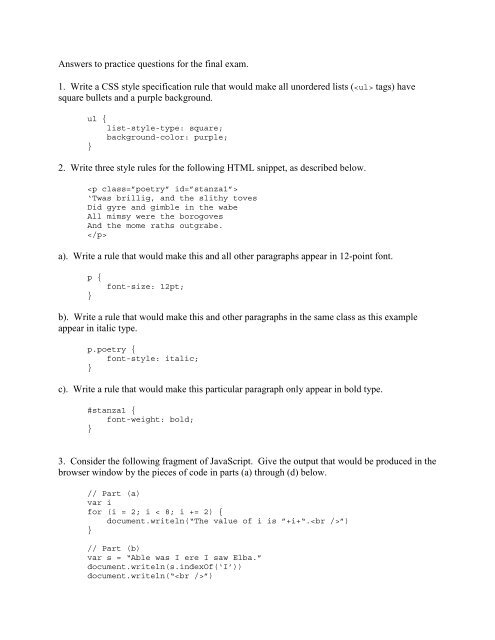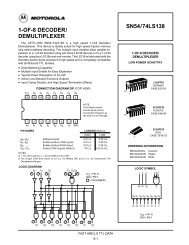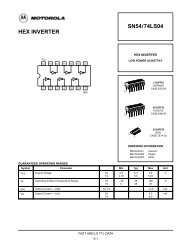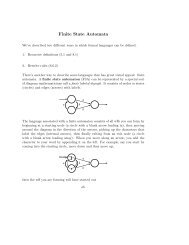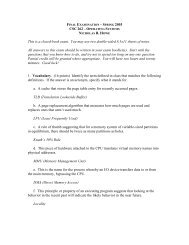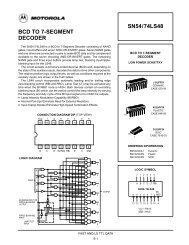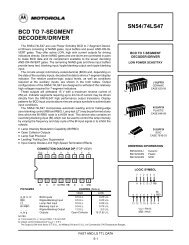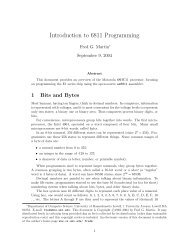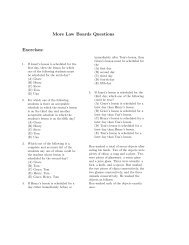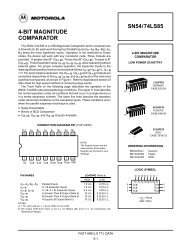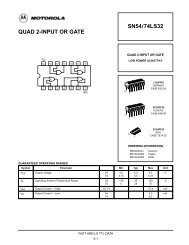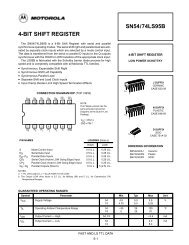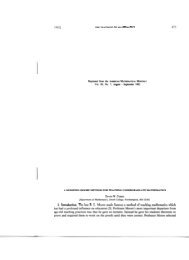Answers to practice questions for the final exam. 1. Write a CSS style ...
Answers to practice questions for the final exam. 1. Write a CSS style ...
Answers to practice questions for the final exam. 1. Write a CSS style ...
- No tags were found...
You also want an ePaper? Increase the reach of your titles
YUMPU automatically turns print PDFs into web optimized ePapers that Google loves.
<strong>Answers</strong> <strong>to</strong> <strong>practice</strong> <strong>questions</strong> <strong>for</strong> <strong>the</strong> <strong>final</strong> <strong>exam</strong>.<strong>1.</strong> <strong>Write</strong> a <strong>CSS</strong> <strong>style</strong> specification rule that would make all unordered lists ( tags) havesquare bullets and a purple background.ul {list-<strong>style</strong>-type: square;background-color: purple;}2. <strong>Write</strong> three <strong>style</strong> rules <strong>for</strong> <strong>the</strong> following HTML snippet, as described below.‘Twas brillig, and <strong>the</strong> slithy <strong>to</strong>vesDid gyre and gimble in <strong>the</strong> wabeAll mimsy were <strong>the</strong> borogovesAnd <strong>the</strong> mome raths outgrabe.a). <strong>Write</strong> a rule that would make this and all o<strong>the</strong>r paragraphs appear in 12-point font.p {}font-size: 12pt;b). <strong>Write</strong> a rule that would make this and o<strong>the</strong>r paragraphs in <strong>the</strong> same class as this <strong>exam</strong>pleappear in italic type.p.poetry {font-<strong>style</strong>: italic;}c). <strong>Write</strong> a rule that would make this particular paragraph only appear in bold type.#stanza1 {font-weight: bold;}3. Consider <strong>the</strong> following fragment of JavaScript. Give <strong>the</strong> output that would be produced in <strong>the</strong>browser window by <strong>the</strong> pieces of code in parts (a) through (d) below.// Part (a)var i<strong>for</strong> (i = 2; i < 8; i += 2) {document.writeln(“The value of i is ”+i+“.”)}// Part (b)var s = “Able was I ere I saw Elba.”document.writeln(s.indexOf(‘I’))document.writeln(“”)
a). Output:b). Output:// Part (c)document.writeln(s.indexOf(‘I’,11))document.writeln(“”)// Part (d)document.writeln(s.substring(12,19))document.writeln(“”)The value of i is 2.The value of i is 4.The value of i is 6.9c). Output:15d). Output:re I sa4. Consider <strong>the</strong> following HTML page. Explain how you would modify <strong>the</strong> given HTML inorder <strong>to</strong> make <strong>the</strong> background change <strong>to</strong> red under <strong>the</strong> specified circumstances,by calling redBG() through an event handler.Test PageA link
a). Immediately when <strong>the</strong> page appears.b). If <strong>the</strong> page is not completely loaded <strong>for</strong> some reason.c). If ano<strong>the</strong>r window is opened on <strong>to</strong>p of <strong>the</strong> current one.d). If <strong>the</strong> user clicks on <strong>the</strong> link.A linke). If <strong>the</strong> user double-clicks on <strong>the</strong> link.A linkf). If <strong>the</strong> user moves <strong>the</strong> mouse over <strong>the</strong> link, and <strong>the</strong>n away.A link5. Below are pairs of JavaScript commands. For each pair, (i) determine whe<strong>the</strong>r a functionshould be used <strong>to</strong> carry out <strong>the</strong> work of both lines, and (ii) if so, give <strong>the</strong> function definition andset of calls <strong>to</strong> it that would replace <strong>the</strong> original pair or commands. An <strong>exam</strong>ple has been done <strong>for</strong>you.a). document.writeln(“My favorite color is blue.”)document.writeln(“My favorite color is red.”)Ans: function tellColor(clr) {// prints a message about my favorite color.document.writeln(“My favorite color is “+clr+”.”)}tellColor(“blue”)tellColor(“red”)b).<strong>to</strong>tal += price1+0.05*price1<strong>to</strong>tal += price2+0.05*price2Ans: function addTax(price) {// adds tax on<strong>to</strong> <strong>the</strong> price.return price+0.05*price}<strong>to</strong>tal += addTax(price1)<strong>to</strong>tal += addTax(price2)
c).document.writeln(“This message will appear in <strong>the</strong> body.”)alert(“This message will appear in a pop-up window.”)It doesn’t make sense <strong>to</strong> use a function here. The differences between <strong>the</strong> two lines include notjust <strong>the</strong> values printed (“This message will appear in <strong>the</strong> body.” vs. “This messagewill appear in a pop-up window.”) but also <strong>the</strong> actions taken with those values(document.writeln() vs. alert()). The two lines don’t have enough in common <strong>to</strong> justifymaking <strong>the</strong>m a function.d).document.getElementById(“link1”).href = “error.html”document.getElementById(“link2”).href = “home.html”Ans: function changeLink(link,newhref) {// changes a link <strong>to</strong> point <strong>to</strong> <strong>the</strong> specified page.document.getElementById(link) = newhref}changeLink(“link1”,“error.html”)changeLink(“link2”,“home.html”)6. Give a complete HTML document that would create a set of frames as follows: <strong>the</strong> right halfof <strong>the</strong> browser window is a single frame named fright showing <strong>the</strong> file right.html. The lefthalf of <strong>the</strong> browser window is divided in<strong>to</strong> an upper portion 135 pixels tall, and two lowerportions taking up one third and two thirds of <strong>the</strong> remainder of <strong>the</strong> window, respectively. Thesethree frames should display <strong>the</strong> files logo.jpg, <strong>to</strong>c.html, and help.html, respectively, andshould be named flogo, f<strong>to</strong>c, and fhelp.Problem #67. <strong>Write</strong> a <strong>for</strong>m that will collect in<strong>for</strong>mation from a visi<strong>to</strong>r and sendit <strong>to</strong> be processed by JavaScript in <strong>the</strong> page summary.html. The <strong>for</strong>mshould collect <strong>the</strong> following in<strong>for</strong>mation: petName (<strong>the</strong> name of a pet),petType (which can be ei<strong>the</strong>r Dog, or Cat, or Bird) and pedigreed (whichis ei<strong>the</strong>r true or false, and should start out checked). Your <strong>for</strong>mshould include a Submit but<strong>to</strong>n, and should demonstrate proper use of<strong>the</strong> tag.Pet’s name:
The pet is a:CatDogBirdPedigree?8. Consider <strong>the</strong> an HTML document with a table in it called table1, and a particular cell in <strong>the</strong>table called cell23. Explain how you would access specific properties of cell23 under <strong>the</strong>document object models specified below (give a piece of JavaScript)....Cell 23 contents...a). How would you refer <strong>to</strong> <strong>the</strong> background color of cell23 in <strong>the</strong> Netscape 4 DOM?document.layers[“cell23”].backgroundColorb). How would you refer <strong>to</strong> <strong>the</strong> text color of cell23 in <strong>the</strong> Microsoft IE DOM?document.all[“cell23”].<strong>style</strong>.colorc). How would you refer <strong>to</strong> width of cell23 in <strong>the</strong> W3C DOM?document.getElementById(“cell23”).widthd). How would you refer <strong>to</strong> <strong>the</strong> cell border of cell23 in <strong>the</strong> Netscape 4 DOM?document.layers[“cell23”].bordere). How would you refer <strong>to</strong> <strong>the</strong> contents of cell23 in <strong>the</strong> Microsoft IE DOM?document.all[“cell23”].innerHTMLf). How would you refer <strong>to</strong> <strong>the</strong> cell padding of cell23 in <strong>the</strong> W3C DOM?document.getElementById(“cell23”).<strong>style</strong>.padding


